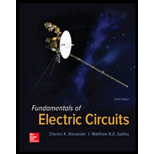
Find the outputs
Answer to Problem 95P
The outputs
Explanation of Solution
Given data:
The state equation of input and output are,
Formula used:
Write the standard form of the state variable equation and for the output equation as follows.
Here,
A, B, C and D are state matrices.
x and z are variable matrices.
Write the formula to find the variable solution
Apply the Laplace transform for x,
Then the solution for the state variable equation can be written as follows.
Here,
I is the identity matrix.
Calculation:
Compare equation (1) with equation (3) and equation (2) with equation (4).
Apply the Laplace transform to above the z matrix.
From equation (2) expand the output equations as follows.
Then the output equations are,
Substitute
Simplify the above equation as follows.
From the above equation,
Apply the partial fraction expansion for the function in equation (9).
Compare the coefficients of
Then, the value of P is,
Therefore, from P, Q relation,
And
Substitute 0.8 for P, –0.8 for Q and –1.8 for R in equation (11).
Apply the inverse Laplace transform to the above equation using the formulas
and
Apply the partial fraction expansion for the function in equation (10).
Compare the coefficients of
Then, the value of E is,
Therefore, from E, F relation,
And
Substitute 1.4 for E, –1.4 for F and –4.4 for G in equation (13).
Apply inverse Laplace transform for the above equation.
Substitute equation (12) and equation (14) in equation (7) to find
Substitute equation (12) in equation (8) to find
Conclusion:
Thus, the outputs
Want to see more full solutions like this?
Chapter 16 Solutions
Fundamentals of Electric Circuits
- Signal and system The mathematical model of a system is y" (t) + ay'(t) + by(t) = a (t) + ca (t) where a=1, b=2 and c=1. 1) Find zeros and poles of the system. 2) Show them onto the S-Plane (the complex plane) 3) Discuss the BIBO stability of the system.arrow_forwardIt is expressed as the state equations of a linear time invariant system. dx(t) / d(t) = Ax(t)+Bu(t) Find the state transition matrix Փ(t), the characteristic equation and the eigenvalues of A for the following systems:arrow_forwardSolve the following differential equations by using Laplace transform method. a) y'' +2y' + y = 4e−t where y(0)= 2 y'(0)= 4 .arrow_forward
- It is expressed as the state equations of a linear time invariant system. dx(t) / d(t) = Ax(t)+Bu(t) Find the state transition matrix Փ(t), the characteristic equation and the eigenvalues of A for the following systemarrow_forwardThe block diagram of a time-invariant, linear, continuous-time system is given below. X1(s) and X2(s) are the state variables of the system. U(s) is the input signal of the system, Y(s) is the output signal of the system. What is the value of parameter E?arrow_forwardSolve the initial value problem y '' – 2y ' – 120y = –60, y(0) = –1.5, y '(0) = 31 using Laplace transformation.arrow_forward
- If G(s) = 1 / (s + 2), find the response c(t) if the input r(t) = u(t), a unit step, assuming zero initial condition.arrow_forwardsolve the difference equation using the z transform: 6yk+2-yk+1-yk=0 where, y(0)=0,y(1)=1arrow_forwardSketch or graph the given function, which is assumed to be zero outside the given interval. Represent it, using unit step functions. Find its Laplace transform using the second shifting theorem. t(0<t<2)arrow_forward
- Find the poles and zeros of the following functions. Mark the finite poles with × and the finite zeros with 0 in the s-plane. G(s) = 10(s+2)/s*(s^2+2s+2)arrow_forwardLaplace transform is applied to a constant coefficient linear differential equation at time t=0 and y(s) = .... is calculated. Accordingly, which of the following is the solution function y(t)?arrow_forwardplease Draw ro Implement the function F (X, Y, Z) = ∑ m (0,3,4,5) using 4-to-1 MUX,arrow_forward
 Introductory Circuit Analysis (13th Edition)Electrical EngineeringISBN:9780133923605Author:Robert L. BoylestadPublisher:PEARSON
Introductory Circuit Analysis (13th Edition)Electrical EngineeringISBN:9780133923605Author:Robert L. BoylestadPublisher:PEARSON Delmar's Standard Textbook Of ElectricityElectrical EngineeringISBN:9781337900348Author:Stephen L. HermanPublisher:Cengage Learning
Delmar's Standard Textbook Of ElectricityElectrical EngineeringISBN:9781337900348Author:Stephen L. HermanPublisher:Cengage Learning Programmable Logic ControllersElectrical EngineeringISBN:9780073373843Author:Frank D. PetruzellaPublisher:McGraw-Hill Education
Programmable Logic ControllersElectrical EngineeringISBN:9780073373843Author:Frank D. PetruzellaPublisher:McGraw-Hill Education Fundamentals of Electric CircuitsElectrical EngineeringISBN:9780078028229Author:Charles K Alexander, Matthew SadikuPublisher:McGraw-Hill Education
Fundamentals of Electric CircuitsElectrical EngineeringISBN:9780078028229Author:Charles K Alexander, Matthew SadikuPublisher:McGraw-Hill Education Electric Circuits. (11th Edition)Electrical EngineeringISBN:9780134746968Author:James W. Nilsson, Susan RiedelPublisher:PEARSON
Electric Circuits. (11th Edition)Electrical EngineeringISBN:9780134746968Author:James W. Nilsson, Susan RiedelPublisher:PEARSON Engineering ElectromagneticsElectrical EngineeringISBN:9780078028151Author:Hayt, William H. (william Hart), Jr, BUCK, John A.Publisher:Mcgraw-hill Education,
Engineering ElectromagneticsElectrical EngineeringISBN:9780078028151Author:Hayt, William H. (william Hart), Jr, BUCK, John A.Publisher:Mcgraw-hill Education,





